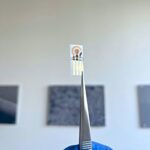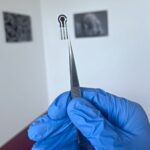CATRIN scientists are the first to use graphene ink for cheap and affordable sensor printing
Do you buy a special ink and print a sensor yourself at home or in the office to detect the presence of bacteria in the body or heavy metals in water? Thanks to scientists from the Czech Advanced Technology and Research Institute—CATRIN—Palacký University Olomouc, this may be common practice in the foreseeable future. CATRIN’s researchers are the first in the world to print a universal electrode for various sensors in an ordinary inkjet printer, using a handmade graphene ink. Compared to commercially used products, this electrode has the same capacity and sensitivity, but thanks to the chosen technology it is significantly cheaper and more affordable. The success of the scientists was presented in the journal Biosensors and Bioelectronics. Electrochemical biosensors are useful not only in medicine, but also for monitoring the quality of food, drinking water or air. Electrodes are a key component, for the production of which graphene-based materials have proved to be very suitable. The fundamentals for the Olomouc success were the preparation of graphene ink with the necessary properties. “Finding inks suitable for printing is not easy because they have to meet a number of criteria that are absolutely crucial for this type of printing, such as the size of the particles in the ink or its viscosity. We succeeded in finding the right combination and made a graphene ink. Thanks to this, we printed an electrode that is universal and of the desired shape. It can be plugged in and used for measuring in any electrochemical lab,” said the first author of the article, Martin-Alex Nalepa, who was involved in CATRIN’s research projects while still a student at the Faculty of Science of Palacký University. The technology is cost-effective, compared to the current procedures, and as for the electrode design only a very small amount of the material is needed thanks to the inkjet printing. “Milligrams of the material is used, following commercial methods, and the electrodes cost at least dozens of Czech korunas. We need about a thousand times less of the material, i.e., the order of micrograms. We calculated the cost of the material for one electrode at about two Czech korunas. The performance is comparable to commercially used sensors, which are prepared by other methods, but the production is very accurate and easy. Moreover, we also care about the environment and therefore we have chosen water as the solvent for the ink,” explained another author, David Panáček, from CATRIN. But the researchers want to go further. The goal is to prepare different types of inks for specific applications by functionalizing graphene, i.e., by attaching a specific molecule that will “catch” the substances of concern. The applications are very diverse—from the detection of microbes, antibiotics, pesticides, markers of some diseases, to pollutants in the environment.“The vision is that the customer buys a functionalized ink, puts it in their own printer and prints the sensor at home or in the office. The printed electrode can now also be connected to a mobile phone and measured with. For example, during the Covid-19 pandemic, there was a lack of tests due to dependence on suppliers from abroad. This system will ensure independence and also significantly expand the range of tests. These are not yet available in pharmacies, with a few exceptions, and people, upon doctor’s recommendation, have to undergo examinations in specialized laboratories, which are rather expensive,” added Panáček.
The authors managed this scientific masterpiece in a record time, despite developing this technology from scratch. “Our long-term collaboration with colleagues from the team of Professor Arben Merkoci’s, from the top research institute ICN2 in Barcelona, helped us with the first steps. Our added value was the great synergy in our multidisciplinary team, which helped to overcome a number of obstacles during the research,” said the group leader, Michal Otyepka.
To prepare a process for the production of graphene ink for printing stable, sensitive and selective electrodes of biosensors and verify them in laboratory conditions is the aim of the prestigious grant of the European Research Council (ERC) in the Proof-of-Concept category, which Otyepka received last year.





